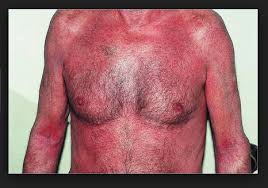 Vancomycin can cause two types of hypersensitivity reactions, the red man syndrome and anaphylaxis.
Vancomycin can cause two types of hypersensitivity reactions, the red man syndrome and anaphylaxis.
The Red man syndrome has often been associated with rapid infusion of the first dose of the drug Vancomycin, and was initially attributed to impurities found in vancomycin preparations.
Other antibiotics (e.g. ciprofloxacin, amphotericinB, rifampicin and teicoplanin) or other drugs that stimulate histamine release can result in red man syndrome.
Discontinuation of the vancomycin infusion and administration of diphenhydramine can abort most of the reactions.
Slow intravenous administration of vancomycin should minimize the risk of infusion-related adverse effects.
Vancomycin is an alternative drug for serious staphylococcal and streptococcal infections, including endocarditis, when allergy precludes the use of penicillins and cephalosporins.
Vancomycin can cause two types of hypersensitivity reactions, the red man syndrome and anaphylaxis
Red man syndrome is an infusion-related reaction peculiar to vancomycin, and consists of pruritus, an erythematous rash that involves the face, neck, and upper torso.
Less frequently, hypotension and angioedema can manifest.
Patients frequently complain of diffuse burning and itching and of generalized discomfort.
Patients can become dizzy, agitated, and can develop headache, chills, fever, and paresthesia around the mouth.
In severe cases, patients chest pain and dyspnea may occur.
Usually the syndrome is a mild, with an evanescent pruritus at the end of the infusion that goes unreported.
Signs of red man syndrome appear about 4–10 min after an infusion started or may begin soon after its completion.
It is often associated with rapid infusion of less than 1 hour, of the first dose of vancomycin.
The reaction may not be of the same severity with successive exposures.
A delayed reactions at or near the end of a 90 or 120 min infusion have been seen in patients who had been on vancomycin therapy for longer than 7 days.
Most protocols require vancomycin to be administered over 60 min, as a minimum.
Sporadic reports of red man syndrome following the administration of vancomycin via routes other than intravenously exist: intraperitoneal and oral administration of vancomycin.
An unknown percentage of the population may be prone to releasing a large amount of histamine in response to vancomycin.
The hypersensitivity reaction that arise is due to vancomycin’s effect on mast cells.
The anaphylactic reaction is mediated by IgE.
Red man syndrome, is an anaphylactoid reaction, is caused by the degranulation of mast cells and basophils, resulting in the release of histamine independent of preformed IgE or complement.
The extent of histamine release is related to the amount and rate of the vancomycin infusion.
Hypersensitivity reaction is most commonly associated with vancomycin is red man syndrome: its incidence varies between 3.7 and 47% in infected patients.
The most severe reactions occur in patients younger than the age of 40, particularly in children.
Other research has found that between 30 and 90% of healthy volunteers receiving vancomycin developed red man syndrome, while only about 47% of those with infections had the reaction.
This is explained that infection induces some histamine release as part of the natural immune response.
In the Red man syndrome the presence off higher histamine levels to begin with is thought to downregulate vancomycin’s effect on mast cells and basophils.
Red man syndrome occurs in 5–13% of patients, especially when the infusion is given over less than 1 hour.
The reaction during a 1 hour infusion of 1 g vancomycin in nine of 11 volunteers (82%), which was associated with a rise in plasma histamine levels.
No reaction occurs with a 500 mg dose.
Symptoms in eight of 10 volunteers (80%) given 1 g vancomycin over 1 hour, but in only three of 10 volunteers (30%) given the same dose over 2 hours.
Total histamine release isngreater with the faster infusion.
Other antibiotics such as ciprofloxacin, amphotericinB, rifampcin and teicoplanin can potentially cause red man syndrome.
They are capable of causing direct degranulation of mast cells and basophils.
The Red man syndrome is amplified if these antibiotics are combined with vancomycin or with each other.
Red man syndrome is also magnified in patients receiving vancomycin and opioids, muscle relaxants, or contrast dyes because these drugs can also stimulate histamine release.
Antihistamines can relieve symptoms of the Red man syndrome.
Pretreatment of vancomycin with hydroxyzine can significantly reduce erythema and pruritus.
Administration of diphenhydramine before starting vancomycin infusion (1 g over 1 hour) can prevent the occurrence of red man syndrome with the first dose of vancomycin.
Combining an H1 receptor blocker with an H2 receptor blocker such as cimetidine may help to prevent or reduce the risk of red man syndrome.
The vancomycin infusion should be discontinued immediately if the RD man syndrome appears.
A dose of 50 mg diphenhydramine hydrochloride intravenously or orally can abort most of the reactions.
The infusion can be resumed at a slower rate and/or at a lesser dosage when the rash and itching dissapates.
Hypotension will require intravenous fluids and, if severe, vasopressors may be needed.
Therapy with a β-blocker before surgery has been found to be protective against hypotension caused by vancomycin infusion.
Intravenous dose of vancomycin should be administered over at least a 60 min interval to minimize the infusion-related adverse effects.
Longer infusion times should be used in patients receiving doses considerably larger than 1 g vancomycin.
